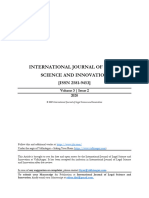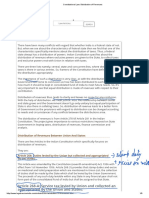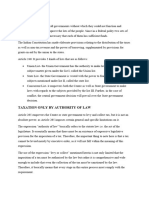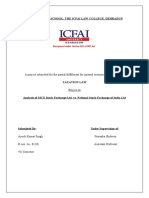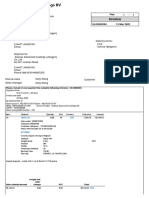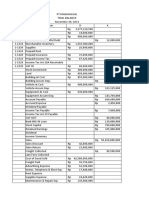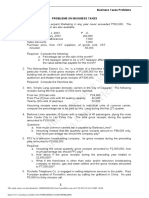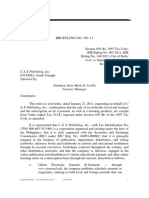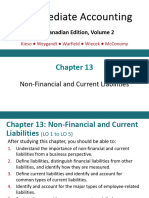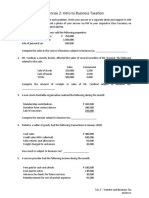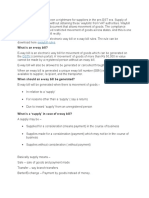Topic 1-Basic Tax Concepts
Uploaded by
sanyasolanki17Topic 1-Basic Tax Concepts
Uploaded by
sanyasolanki17CHAPTER 1
BASIC INCOME TAX CONCEPTS
Table of Contents
1. WHAT IS TAX? ......................................................................................................................... 2
2. OBJECTIVES OF TAXATION ....................................................................................................... 2
3. CONSTITUTIONAL PROVISIONS RELATING TO TAXATION .......................................................... 4
4. OVERVIEW OF INCOME-TAX LAW .......................................................................................... 12
5. IMPORTANT DEFINITIONS ..................................................................................................... 16
6. TAX RATES AT A GLANCE (PY 23-24/AY 2024-25) ........................................................... 33
Basic Income Tax Concepts
1. W HAT IS T AX ?
Government needs money for financing of defense, infrastructural development
such as construction of roads, dams, power projects, railways, health services
etc.
Funds for all these requirements are collected by way of taxes. Taxes are
broadly classified into two types namely Direct Taxes and Indirect Taxes.
Direct Taxes Indirect Taxes
Levied on Income, Wealth Levied on Goods and Services
Burden is on the shoulders of the Burden is shifted on ultimate
taxpayers consumer
Progressive in nature Regressive in nature
Higher collection costs as tax Lower collection costs as tax
collection is difficult collection is easier
e.g. Income Tax e.g. Goods and Services Tax (GST),
Customs, etc.
2. O BJECTIVE S OF T AXATION
Economic Development: Taxes fund government projects and initiatives that
foster economic growth, such as infrastructure development, education, and
technology advancements.
BA/BBA LLB V/LLB III 2 CA Mukta Kunte
Basic Income Tax Concepts
Price Stability: By adjusting tax rates, the government can control inflation and
deflation, stabilizing prices and ensuring a balanced economy.
Employment Generation: Revenue from taxes is used to create job opportunities
through public projects and government-funded employment programs. Concession
is provided to certain sector in order to develop and hence the employment
increases..
Income Redistribution: Progressive tax systems ensure that higher-income
individuals contribute more, which helps to reduce income inequality and support
welfare programs for the less privileged.
Regulate Production of Harmful Substances: Taxes on goods like tobacco,
alcohol, and sugary drinks discourage their consumption, promoting public health.
Controls Monopoly: Taxation can curb monopolistic practices by imposing higher
taxes on dominant companies, encouraging competition.
Protect Domestic Industries: Import taxes (tariffs) can protect local industries
from foreign competition, helping them to grow and sustain local employment.
Increased Habit of Saving and Strategic Investment: Tax incentives for
savings and investments encourage individuals and businesses to save and invest
more strategically, promoting economic stability.
BA/BBA LLB V/LLB III 3 CA Mukta Kunte
Basic Income Tax Concepts
3. C ONSTITUTIONAL P ROVISIONS R ELATING TO
T AXATION
ADMINISTRATION OF INDIA
CENTRE STATE
LAW JUSTICE IMPLEMENTATION
PARLIAMENT SUPREME COURT FINANCE MINISTRY
(Head – President) (Department of Revenue)
LOKSABHA RAJYASABHA PARLIAMENT HIGH COURT FINANCE
COMMITTEES MINISTER
TRIBUNAL
CIT (A) CBDT CBEC
INCOME-TAX GST /
DEPARTMENT CUSTOMS
DEPARTMENTS
BA/BBA LLB V/LLB III 4 CA Mukta Kunte
Basic Income Tax Concepts
Article 265
Article 265- No tax can be levied without the authority of the law.
Article 265 of the Constitution of India states that no tax can be levied or collected
except by the authority of law. This means that all taxes must be imposed by a valid law
and that no tax can be levied or collected without the authority of law.
In the case of Tangkhul v. Simerei Shailei, the Supreme Court held that the practice
of villagers paying Rs. 50 a day to the headman in place of a custom to render free a
day’s labour was a collection of tax and that no law had authorised it. Therefore, it
violated Article 265.
Article 266
Article 266 of the Constitution of India deals with the Consolidated Funds and Public
Accounts of India and the States. It states that the following shall form one consolidated
fund to be entitled the Consolidated Fund of India:
The whole or part of the net proceeds of certain taxes and duties to States
All loans raised by the Government by the issue of treasury bills
All money received by the Government in repayment of loans
All revenues received by the Government of India
Loans or ways and means of advances
The same holds for the revenues received by the Government of a State which it is
called the Consolidated Fund of the State. Money out of the Consolidated Fund of India
or a State can be taken only in agreement with the law and for the purposes and of the
Constitution.
Article 267:
It deals with the contingency fund of India.
Article 268
Article 268 of the Constitution of India deals with duties levied by the Union government
but collected and claimed by the State governments. These duties include stamp duties,
excise on medicinal and toilet preparations, etc. These duties collected by states do not
form a part of the Consolidated Fund of India but are with the state only.
Article 269
Article 269 of the Constitution of India provides the list of various taxes that are levied
and collected by the Union and the manner of distribution and assignment of Tax to
States. These taxes include taxes on income other than agricultural income, taxes on
corporation tax and duties of customs.
The taxes mentioned in Article 269 are levied and collected by the Union government,
but the proceeds are assigned to the States. This is done to ensure that the States have
a fair share of the tax revenue and that they are able to raise the resources they need to
provide essential services to their citizens.
BA/BBA LLB V/LLB III 5 CA Mukta Kunte
Basic Income Tax Concepts
The case of M/S. Kalpana Glass Fibre Pvt. Ltd. Maharashtra v. State of Orissa and
Others is an example of how Article 269 has been interpreted by the courts. In this
case, the Supreme Court held that the State Sales Tax Act was not applicable to sale or
purchase in the course of interstate trade or commerce. This is because Article 269
prohibits the levy and collection of tax on sale or purchase in the course of interstate
trade or commerce.
Article 269A
Article 269(A) of the Constitution of India was inserted by the 122nd Amendment of the
Constitution in 2017. This article gives the power to collect goods and services tax (GST)
on supplies in the course of inter-state trade or commerce to the Government of India.
The proceeds of this tax are then apportioned between the Union and the States in the
following manner:
50% of the proceeds are directly apportioned to the States.
The remaining 50% is credited to the Consolidated Fund of India (CFI). Out of this
amount, a prescribed percentage is then distributed to the States.
The percentage of the proceeds that are distributed to the States through the CFI is
determined by the Goods and Services Tax Council (GST Council). The GST Council is a
body that is constituted by the Union and the States to recommend the principles that
should be followed in determining the rates of GST, the exemptions from GST and the
distribution of the proceeds of GST between the Union and the States.
The direct apportionment of 50% of the proceeds of GST to the States is intended to
ensure that the States have a fair share of the revenue generated by GST. The
distribution of the remaining 50% of the proceeds through the CFI is intended to take
into account the relative needs of the States.
The introduction of Article 269(A) has had a significant impact on the taxation system in
India. It has simplified the taxation system by removing the need for multiple taxes on
goods and services that are in transit between different States. It has also helped to
ensure that the States have a fair share of the revenue generated by GST.
Article 270
Article 270 of the Constitution of India deals with the taxes levied and distributed
between the Union and the States. It states that the following taxes are levied and
collected by the Union government and the proceeds are distributed between the Union
and the States in the following manner:
All taxes and duties mentioned in the Union List, except the duties and taxes
mentioned in Articles 268, 269 and 269A.
Taxes and surcharges on taxes, duties and cess on particular functions are specified in
Article 271 under any law created by Parliament.
The proceeds from these taxes are distributed between the Union and the States in the
following manner:
The proceeds of taxes levied on the sale or purchase of goods and services in the
course of inter-state trade or commerce are distributed to the States in the ratio of
their population.
The proceeds of other taxes are distributed to the States in such manner as may be
prescribed by the Parliament.
BA/BBA LLB V/LLB III 6 CA Mukta Kunte
Basic Income Tax Concepts
The distribution of the proceeds of taxes between the Union and the States is
determined by the Finance Commission, which is a body constituted by the Parliament
every five years. The Finance Commission takes into account a number of factors,
including the needs of the States, the resources of the States and the overall economic
situation of the country, in determining the distribution of the proceeds of taxes between
the Union and the States.
Article 271
Article 271 of the Constitution of India allows the Parliament to increase any of the taxes
or duties mentioned in Articles 269 and 270 by levying an additional surcharge for a
particular purpose. The proceeds from the surcharge are credited to the Consolidated
Fund of India
Article 273
This article provides for grants to the States of Assam, Bihar Orissa and West Bengal in
lieu of any share of the net proceeds of the export duty on jute and jute products. The
grants are charged to the Consolidated Fund of India and are to be made for a period of
ten years from the commencement of the Constitution.
Article 275
This article provides for grants-in-aid to the States by the Union government. The grants
are to be made on the recommendation of the Finance Commission. The grants are to be
used for the development of the States and for the welfare of the people.
Article 276
This article provides for taxes that are levied by the States. The taxes are to be levied
and collected by the States. The taxes that can be levied by the States include sales tax,
value-added tax (VAT), professional tax and stamp duty.
Article 277
Article 277 of the Constitution of India provides that cesses, fees, duties or taxes which
were levied immediately before the commencement of the Constitution by any
municipality or other local authority for the purposes of the State, despite being
mentioned in the Union List, can continue to be levied and applied for the same purposes
until a new law contradicting it has been passed by the Parliament.
This article was enacted to protect the interests of the States and the local authorities. It
ensures that the States and the local authorities can continue to raise revenue from
taxes that were already being levied before the commencement of the Constitution. This
revenue can then be used for the benefit of the people of the State or the local area.
Article 279
Article 279 of the Constitution of India deals with the calculation of “net proceeds”. Net
proceeds are the proceeds of a tax or duty after deducting the cost of collection, as
ascertained and certified by the Comptroller and Auditor-General of India.
Article 279A
It provides for GST council.
The Goods and Services Tax Council shall consist of the following members, namely:—
BA/BBA LLB V/LLB III 7 CA Mukta Kunte
Basic Income Tax Concepts
(a) the Union Finance Minister — Chairperson;
(b) the Union Minister of State in charge of Revenue or Finance — Member;
(c) the Minister in charge of Finance or Taxation or any other Minister nominated by each
State Government — Members.
Article 282
Article 282 of the Constitution of India provides for grants by the Union government to
the States for any public purpose. The grants can be made for special, temporary or ad
hoc schemes. The power to grant sanctions under Article 282 is not restricted.
Article 286
Article 286 of the Constitution of India restricts the power of the States to tax. It states
that the States cannot:
Impose taxes on imports or exports.
Impose taxes on sales or purchases that take place outside the territory of the State.
Impose taxes on goods that are of special importance, unless the Parliament has
authorised them to do so.
The Parliament has the power to lay down principles to determine when a sale or
purchase takes place during import or export or outside the territory of the State. The
Parliament can also restrict the power of the States to tax goods of special importance.
Article 289
It states that property and income of the state cannot be taxed by the central
government.
New Articles 246A, 269A & 279A
for launch of GST
3.1. ARTICLE 246 READ WITH SCHEDULE VII
The Constitution of India, as the supreme authority, contains separate provisions
to regulate power of taxation and to ensure distribution of such power between
the Central Government and the States. Distributions of power to make laws as
per Article 246 read with the three lists to Schedule VII are as follows:
Table showing significant taxes and the various entries in union and
state lists
BA/BBA LLB V/LLB III 8 CA Mukta Kunte
Basic Income Tax Concepts
Sr. Union List (List I) State List (List II)
No.
1. Income tax Agricultural Income Tax Entry 46 –
Taxes on agricultural income.
Entry 82 - Taxes on income
other than agricultural income
2. Customs Duties State Excise Duties
Entry 83 – Duties of customs including Entry 51 - Duties of excise on alcoholic
export duties liquors for human consumption; opium,
Indian hemp and other narcotic drugs
and narcotics. The entry does not include
duties of excise on medicinal and toilet
preparations containing alcohol or
opium/Indian hemp/narcotic
drugs/narcotics
3. Central Excise Duties (Entry Entry Tax(Entry Repealed post GST)
Amended - petroleum and tobacco
products liable) Entry No 52
Entry 84 –
Duties of excise on tobacco and other
goods manufactured or produced in
India except alcoholic liquors for human
consumption; opium, Indian hemp and
other narcotic drugs and narcotics, but
including medicinal and toilet
preparations containing alcohol or
opium/Indian hemp /narcotic
drugs/narcotics
4. Central Sales Tax (Entry retained State Level VAT (Entry amended -
will continue for products not petroleum and alcohol liable)
covered in GST)
Entry 54 - Taxes on the sale or purchase
Entry 92A - Taxes on the sale or of goods (excluding newspapers) except
purchase of goods other than tax on inter-State sale or purchase
newspapers, where such sale or
purchase takes place in the course of
inter-State trade or commerce
5. Entry 92C – Tax on services (Entry Taxes on luxury, entertainment and
Repealed post GST) amusement
[Amendment passed by the Parliament Entry No 62(Amended to provide
on 15.1.2005, but was not made that taxes will be subsumed by GST
effective] unless levied by local authorities)
6. Residual Entry Entry 97 - Any other Other Taxes
matter not enumerated in List II or List
III including any tax not mentioned in Stamp Duty
BA/BBA LLB V/LLB III 9 CA Mukta Kunte
Basic Income Tax Concepts
either of those Lists Profession tax
Electricity Duty
Motor Vehicle Tax
It may be noted that the Central Govt. has exclusive power to impose taxes
which are not specifically mentioned in the State or Concurrent lists. Further, the
property of CG is exempted from State taxation and income of states is
exempted from Union taxation.
Agricultural Income Taxation
As per the Indian Income Tax Act, 1961, agricultural income is exempt from
Central Government taxation because it falls under the State List. Each state in
India has unique climatic conditions, and factors such as excessive or insufficient
rainfall can significantly impact crop yields. Consequently, the authority to tax
agricultural income is vested in the State Governments. This provision allows
states to tailor agricultural policies and tax regulations to their specific
conditions, providing more responsive and appropriate support to the
agricultural sector.
Interstate Commerce Taxation
The taxation of interstate commerce falls under the jurisdiction of the Central
Government. State Governments do not have the authority to tax goods and
services that move across state borders. This ensures a uniform tax structure
and prevents multiple states from imposing taxes on the same transaction,
which could hinder the free flow of trade and commerce across state lines.
Centralized control of interstate commerce taxation maintains a seamless
national market and avoids complications that could arise from varying state-
level taxes on interstate transactions.
3.2.BUDGET
The Union Budget of India, also referred to as the Annual Financial Statement in
the Article 112 of the Constitution of India is the annual budget of the Republic
of India. Union Budget keeps the account of the government's finances for the
BA/BBA LLB V/LLB III 10 CA Mukta Kunte
Basic Income Tax Concepts
fiscal year that runs from 1st April to 31st March. Union Budget is classified into
Revenue Budget and Capital Budget.
Revenue budget includes the government's revenue receipts and expenditure.
There are two kinds of revenue receipts - tax and non-tax revenue. Revenue
expenditure is the expenditure incurred on day to day functioning of the
government and on various services offered to citizens.
Capital Budget includes capital receipts and payments of the government. Loans
from public, foreign governments and RBI form a major part of the
government's capital receipts. Capital expenditure is the expenditure on
development of machinery, equipment, building, health facilities, education etc.
Fiscal deficit is incurred when the government's total expenditure exceeds its
total revenue.
The budget process in India, like in most other countries, comprises four distinct
phases.
Budget formulation: the preparation of estimates of expenditure and receipts
for the ensuing financial year;
Budget enactment: approval of the proposed Budget by the Legislature
through the enactment of Finance Bill and Appropriation Bill;
Budget execution: enforcement of the provisions in the Finance Act and
Appropriation Act by the government—collection of receipts and making
disbursements for various services as approved by the Legislature; and
Legislative review of budget implementation: audits of government’s
financial operations on behalf of the Legislature.
The Government presents it on the first day of February so that it could be
materialised before the beginning of new financial year in April. The budget,
which is presented by means of the Finance bill and the Appropriation bill has to
be passed by Lok Sabha before it can come into effect on April 1, the start of
India's financial year.
BA/BBA LLB V/LLB III 11 CA Mukta Kunte
Basic Income Tax Concepts
4. O VERVIEW OF I NCOME -T AX L AW
4.1.1. THE INCOME-TAX ACT, 1961
Entry No 82 of Union List provides for Taxes on Income other than
Agricultural Income.
Chapter
Title Content Sections
No.
I Preliminary Title & Definitions 1-3
Charge & Scope of Total
II Basis of charge 4-9
Income
Incomes not forming part of
III Exemptions 10-13B
Total Income
IV Computation of total income Heads of Income 14-59
Income of other person
V Clubbing provisions 60-65
included in assessee’s income
Aggregation of income and set Set-off and carry forward of
VI 66-80
off/ carry forward losses
Deductions while computing
VI-A Deductions 80A-80U
total income
Income forming part of income
VII Share of AOP/BOI 86
on which no tax payable
VIII Rebates and Reliefs Rebate 87-89
IX Double Taxation Relief Provisions relating to DTAA 90-91
Special provisions relating to
X Transfer pricing 92-94A
avoidance of tax
GAAR (Deferred for
XA General Anti Avoidance Rule 95-102
implementation)
Non-resident taxation, MAT &
XII – Determination of tax in certain DDT, Income from shipping 110-
XIIG cases companies(Special Rates of 115VZC
tax)
XIII Income-Tax Authorities Appointment & Powers 116-138
BA/BBA LLB V/LLB III 12 CA Mukta Kunte
Basic Income Tax Concepts
Chapter
Title Content Sections
No.
139-
XIV Procedure for assessment Return & Assessment
158BI
Representative assessee
XV Liability in Special Cases 159-180A
Firms, AOP, BOI
Change in
XVI Special provisions for Firms constitution/dissolution/succe 184-189A
ssion
XVII Collection and Recovery of Tax TDS & Advance tax 190-234E
XVIII Relief from tax on dividends Relief on certain dividends 236-236A
XIX Refunds Refunds & Interest 237-245
245A-
XIX-A Settlement of Cases Settlement Commission
245L
Authority 245N-
XIX-B Advance Rulings
Procedural aspects 245V
XX Appeals and Revision Different appellate levels 246-269
XXA- Immovable property Immovable property 269A-
XXC acquisitions acquisitions 269UP
XXI Penalties Imposable Penalties 270-275
Consequences on failure to 275A-
XXII Offences and Prosecutions
comply with the Act 280D
R/off, power to remove
XXIII Miscellaneous 281-298
difficulties etc.
The Income Tax Act, 1961 is an act to levy, administer, collect, and recover
income tax in India. The act is effective from 1 April 1962. It consists of
298 sections and 14 schedules. It applies to whole of India. The act helps
determine a taxpayer’s taxable income, tax liability, appeals, penalties, and
prosecution. The government has been making amendments to the act from
time to time.
Normally, the Act comprises of the following:
Section- A section is the distinct and numbered subdivisions in legal codes.
BA/BBA LLB V/LLB III 13 CA Mukta Kunte
Basic Income Tax Concepts
Sub-section- A sub-section is a part of a section. When parts of a section
are interrelated, or when one whole provision emerges out by putting all the
parts of the section together, then those parts are referred to as sub-
sections.
Clauses- A clause maybe a part of either a section or a sub-section. When
these parts are independent of each other and are not interrelated then
these are referred to as clauses.
Subclauses - Sub clause is a subordinate clause.
When parts of a section are interrelated, or when one whole provision
emerges out by putting all the parts of the section together, then
those parts are referred to as sub-sections. Whereas, when these
parts are independent of each other and are not interrelated then
these are referred to as clauses.
Proviso - The function of a proviso is to qualify something or to exclude,
something from what is provided in the enactment. It basically spells out an
exception to the given provision.
Explanation- Explanation gives the clarification, provides additional support
to the main provision.
4.1.2. INCOME TAX RULES, 1962 (‘RULES’)
Section 295 empowers the CBDT to make rules for carrying out the
purpose of the Act
Supplements the provisions of the Act - Rules cannot override the
provisions of the Act [CIT vs Chenniapa Mudaliar (SC)]
The Rule relevant to a particular section is referred to in the footnotes to
the section. Rules also have sub-rules, provisos and Explanation.
BA/BBA LLB V/LLB III 14 CA Mukta Kunte
Basic Income Tax Concepts
The Rules:
Provide the procedural aspect of the tax machinery
Prescribe the formats of various documents, certificates and returns, the
method of valuation of perquisite, manner to be adopted for conversion,
rates of depreciation, etc.
4.1.3. FINANCE ACTS
The Finance Minister of the Union Govt presents the Finance Bill in both Houses
of Parliament. Part A of the budget speech contains the proposed policies of the
Govt in fiscal areas. Part B contains the direct tax proposals. Finance Bill is
usually presented in the Parliament by finance minister on the first day of
February every year. Once the bill has been passed by the parliament after
necessary amendments then it goes to the President for his assent.
The Finance bill becomes the Finance Act after the President has
assented to it.
The Finance Act brings amendments to both the Direct Tax Law as well as the
Indirect Tax laws. The effective date for applicability of amendments in direct
taxes is usually mentioned in the notification in the official gazette or in the Act
itself. However, indirect tax rates are effective from the midnight of the date of
presentation of the Union Budget.
First schedule to the Finance Act provides the following rates of taxation:
• Part I: Tax rates applicable for the current AY. E.g. Schedule I to the
Finance Act 2024 –Part I provides tax rates for AY 2024-25 (i.e. PY 2023-
24)
• Part II: TDS rates during the financial year E.g. Schedule I to the Finance
Act 2024 –Part II provides TDS rates for PY 2024-25
• Part III: TDS rate for salary and Advance Tax rate (which becomes Part I
of the next Finance Act) E.g. Schedule I to the Finance Act 2024 – Part III
provides tax rates for AY 2025-26 (i.e. PY 2024-25)
• Part IV: Rules for computing Net agricultural income
BA/BBA LLB V/LLB III 15 CA Mukta Kunte
Basic Income Tax Concepts
4.1.4. NOTIFICATIONS/CIRCULARS/ INSTRUCTIONS/ CASE LAWS
CBDT empowered to issue notifications, circulars, instructions, directions
etc. to the Income tax authorities
Such notifications, circulars, instructions etc. have a binding effect on the
Revenue authorities. Circulars are not binding on the assesses but they
can take advantage of beneficial circular.
Instructions: Internal to the Income Tax Department
Circulars: Clarify the section
Notifications: To give information / notify certain projects /schemes
[section will read ‘as may be notified from time to time’]
Case laws form a vital part for law. The judgments help in interpreting the
statute. The decisions of Supreme Court are binding on everyone. It is
treated as a law of land. Further, the High Court judgments apply in
respective jurisdictions.
5. I MPORTANT D EFINITIONS
5.1. INDIA [SECTION 2(25A)]
India means the territory of India as per article 1 of the
constitution, its territorial waters, seabed and subsoil
underlying such waters, continental shelf, exclusive
economic zone or any other specified maritime zone and
the air space above its territory and territorial waters.
5.2.ASSESSEE [SECTION 2(7)]
Assessee means a person by whom any tax or other sum of money is
payable under this act & includes the following:
1. Every person in respect of whom any proceeding under the Income tax
act has been taken,
BA/BBA LLB V/LLB III 16 CA Mukta Kunte
Basic Income Tax Concepts
a. for the assessment of his income
b. to determine loss sustained by him
c. to determine the amount of refund due to him
2. Representative assessee
3. Every person who is deemed to be assessee in default under any provision
of this Act. For e.g. a person paying interest to another person is responsible
for deducting tax at source on this amount and to deposit the tax with the
government, if he fails in either of these duties, he shall be deemed to be an
assessee in default.
5.3. ASSESSMENT [SECTION 2(8)]
Assessment is the procedure by which the income of an assessee is determined
by the Assessing Officer.
5.4. PERSON [SECTION 2(31)]
Person includes:
1) An Individual
An Individual means a natural person ie human being
It includes Male/Female
In case of Minor/Unsound Mind – Guardian or Manager
Deceased Person – Legal Representative
2) Hindu Undivided Family (HUF)
HUF has not been defined under Income-tax Act, 1961. It is governed by
Hindu law, consist of all males lineally descended from common ancestor
and includes wives and daughters.
Members of HUF who have right to partition are called as Co-Parceners.
A Hindu Coparcenery includes those persons who acquire an interest in
joint family property by birth. Further Son and Daughter of HUF have
same right in Coparcenary Property.
Arises from Status, not from contract.
There is no requirement of having atleast two coparceners to form HUF.
BA/BBA LLB V/LLB III 17 CA Mukta Kunte
Basic Income Tax Concepts
Under Income-tax Act Jain undivided families and Sikh undivided families
would also be assessed as HUF.
Dayabhaga and Mitakshara are the two schools of Hindu law that relate
to inheritance in families.
The difference between Dayabhaga and Mitakshara is in the basic idea of
them. Dayabhaga does not give anyone the right to property before the
death of their forefathers. Hence father and his brothers would be the
coparceners of the HUF. Whereas Mitakshara gives anyone the right to
property just after their birth. Dayabhaga school is prevalent in West
Bengal and Assam and Mitakshara in the rest of India.
3) Company
“Company” means
1. Any Indian company (I Co),or
2. Anybody corporate incorporated by or under the laws of a country
outside India (‘F Co), or
3. Any institution, association or body which is or was assessable or was
assessed as a company under the Indian Income-tax Act, 1922 or for
any assessment year commencing on or before the 1stday of April 1970
under the present Act (Pre Co) or
4. Any institution, association or body, whether incorporated or not and
‘whether Indian or non-Indian, which is declared by general or special
order of the CBDT to be a company. Provided that such institution,
association or body shall be deemed to be a company only for such
assessment year or assessment years as may be specified in the
declaration. (CBDT forced Co)
The expression company as defined in the Act has a wider connotation than
what is normally understood as company under Companies Act. Further,
under the Act company is assessed separately although the companies
might be interrelated/ interconnected e.g. holding-subsidiary, sister
concerns etc. This is because they have a separate and distinct legal
existence.
TYPES OF COMPANIES
BA/BBA LLB V/LLB III 18 CA Mukta Kunte
Basic Income Tax Concepts
Domestic Company (Includes Indian Company)
Foreign Company
Widely-held Company (Public Company)
Closely-held Company (Private Company)
Following are the types of companies under Income-tax Act:
3.1. Domestic Company
As per section 2(22A) “Domestic Company” means an Indian company,
or any other company, which in respect of its income liable to tax under
this Act, has made the prescribed arrangement for the declaration and
payment, within India, of the dividends (including dividends on preference
shares) payable out of such income.
3.2. Indian Company
As per section 2(26) of the Income-tax Act, “Indian Company” means a
company formed and registered under Companies Act, 1957, and include-
1. A company formed and registered under any law relating to companies
formerly in force in any part of India (other than the State of Jammu
and Kashmir and the ‘Union territories specified in v below);
2. a corporation established by or under a Central, State or ‘Provisional
Act;
3. any institution, association or body “which is declared by the Board to
be a company under section 2(17);
4. In the case of the State of Jammu and Kashmir, a company formed and
registered under any law for the time being in force in that State.
5. In the case of any of the ‘Union territories of ‘Dadra and Nagar Haveli,
Goa, ‘Daman and Diu’, and ‘Pondicherry’, a company formed and
registered under any law for the time being in force in that ‘Union
territory
Hence, all Indian companies are domestic companies; however, all
domestic companies need not necessarily be Indian companies.
BA/BBA LLB V/LLB III 19 CA Mukta Kunte
Basic Income Tax Concepts
3.3. Foreign Company
As per section 2(23A) “Foreign Company” means a company, which is
not a domestic company. It may be noted that all non-Indian companies
need not necessarily be foreign companies. If a non-Indian Company has
made the prescribed arrangements for declaration and payments of
dividends within India, then it should be treated as domestic company.
4) Firm
Firm has same meaning as assigned under Indian partnership Act, 1932.
Persons agree to share Profit of business carried by all or any of them
acting for all. Individually known as Partners and collectively known as
Firm.
Term also includes LLP as define under Limited Liability Partnership Act,
2008.
5) Association of Persons (AOP)
When persons combine together to carry on a joint enterprise and they do
not constitute partnership under the ambit of law, they are assessable as
an association of persons.
Receiving income jointly is not the only feature of an association of
persons. There must be common purpose, and common action to
achieve common purpose i.e. to earn income.
An AOP. can have firms, companies, associations and individuals as its
members.
Co-operative societies, MARKFED, NAFED etc. are the examples of such
persons.
6) Body of Individuals (BOI)
It consists of individuals only.
A body of individuals cannot have non-individuals as its members. Only
natural human beings can be members of a body of individuals.
Status of person like Executors and Trustees are covered under BOI.
Co-executors or co-trustees are assessable as a BOI as their title and
interest are indivisible.
The basic difference between AOP & BOI
BA/BBA LLB V/LLB III 20 CA Mukta Kunte
Basic Income Tax Concepts
An AOP may consist of non-individuals but BOI has to consist of
individuals only.
In case of AOP, members voluntarily come together with a common will
for a common intention or purpose, whereas in case of BOI, such
common will may or may not be present.
7) Local Authority (LA)
Authority Legally entitled or entrusted by Government with the control or
management of municipal or local fund
E.g. Municipal Committee, District Board etc.
8) Artificial Juridical Persons (AJP)
AJP are the entities which are not natural persons but are separate
entities in the eyes of law.
This is a residual category could cover all artificial persons with a juristic
personality not falling under any other category of persons.
Deities, Bar Council, Universities are some important examples of AJP
I In case of AOP, BOI and AJP profit motive
is not essential
Income tax rate vary according to the status……
5.5. ASSESSMENT YEAR (‘AY’) [SECTION 2(9)]
Assessment year is a year in which income is charged to tax or year in
which income tax is payable. It is always a period of 12 months
commencing on 1st April every year.
5.6. PREVIOUS YEAR (‘PY’) [SECTION 3]
BA/BBA LLB V/LLB III 21 CA Mukta Kunte
Basic Income Tax Concepts
Previous year is a year in which income is earned. It is same as Financial
Year. All assessees are required to follow financial year (i.e., 1 April to 31 March)
as the previous year. This uniform previous year has to be followed for all
sources of income.
Example – If Previous Year is 23-24 then Assessment Year is 24-25.
In case of newly set up businesses during the financial year, first previous year
starts on the date of setting up and it ends on 31st March of the said financial
year. Hence, first PY for newly set up businesses can be less than one year.
If source of income comes into existence in the said financial year, then the PY
will commence from the date on which the source of income newly comes into
existence and will end on 31 March of the financial year.
Income earned in a year is taxable in the next year.
Year of earning income is PY and next year to that is AY.
Exception: In following cases, income of PY is taxable in the same year in which
income is earned.
• Income of non-resident from shipping (Sec 172)
• Income of person leaving India without intention of returning to
India (Sec 174)
• Income of bodies formed for short duration/event/purpose (Sec
174A)
• Person likely to transfer property to avoid tax (Sec 175)
• Income of discontinued business at the discretion of assessing
officer may be taxed in the PY (Sec 176)
BA/BBA LLB V/LLB III 22 CA Mukta Kunte
Basic Income Tax Concepts
5.7. MEANING OF INCOME [SECTION 2(24)]
Income is a periodical monetary return with some sort of
regularity. The definition of income in section 2(24) of the
Act is inclusive and not exhaustive.
Section 2(24) of the Act gives a statutory definition of income. At present, the
following items of receipts are specifically included in income:—
1) Profits and gains.
2) Dividends.
3) Voluntary contributions received by a trust/institution created wholly or
partly for charitable or religious purposes or by certain research association
or universities and other educational institutions or hospitals and other
medical institutions or an electoral trust.
4) The value of any perquisite or profit in lieu of salary taxable under section 17
5) Any special allowance or benefit other than the perquisite included above,
specifically granted to the assessee to meet expenses wholly, necessarily
and exclusively for the performance of the duties of an office or employment
of profit.
6) Any allowance granted to the assessee to meet his personal expenses at the
place where the duties of his office or employment of profit are ordinarily
performed by him or at a place where he ordinarily resides or to compensate
him for the increased cost of living.
7) The value of any benefit or perquisite whether convertible into money or not,
obtained from a company either by a director or by a person who has a
substantial interest in the company or by a relative of the director or such
person and any sum paid by any such company in respect of any obligation
which, but for such payment would have been payable by the director or
other person aforesaid.
8) The value of any benefit or perquisite, whether convertible into money or
not, which is obtained by any representative assessee or by any beneficiary
or any amount paid by the representative assessee for the benefit of the
beneficiary which the beneficiary would have ordinarily been required to pay.
9) Deemed profits chargeable to tax under section 41 or section 59.
10) Profits and gains of business or profession chargeable to tax under section
28.
11) Any capital gains chargeable under section 45.
BA/BBA LLB V/LLB III 23 CA Mukta Kunte
Basic Income Tax Concepts
12) The profits and gains of any insurance business carried on by Mutual
Insurance Company or by a cooperative society, computed in accordance
with Section 44 or any surplus taken to be such profits and gains by virtue of
the provisions contained in the first Schedule to the Act.
13) The profits and gains of any business of banking (including providing credit
facilities) carried on by a co-operative society with its members.
14) Any winnings from lotteries, cross-word puzzles, races including horse races,
card games and other games of any sort or from gambling, or betting of any
form or nature whatsoever.
15) Any sum received by the assessee from his employees as contributions to
any provident fund (PF) or superannuation fund or Employees State
Insurance Fund (ESI) or any other fund for the welfare of such employees.
16) Any sum received under a Keyman insurance policy including the sum
allocated by way of bonus on such policy will constitute income.
17) Any sum referred to clause (va) of section 28. Thus, any sum, whether
received or receivable in cash or kind, under an agreement for not carrying
out any activity in relation to any business or profession; or not sharing any
know-how, patent, copy right, trade-mark, licence, franchise, or any other
business or commercial right of a similar nature, or information or technique
likely to assist in the manufacture or processing of goods or provision of
services, shall be chargeable to income tax under the head “profits and gains
of business or profession”.
18) Fair market Value of inventory which is converted into or treated as a capital
asset
19) Any consideration received for issue of shares as exceeds the fair market
value of the shares [Section 56(2)(viib)].
20) Any sum of money received as advance, if such sum is forfeited consequent
to failure of negotiation for transfer of a capital asset [Section 56(2)(ix)].
21) Any sum of money or value of property received without consideration or for
inadequate consideration by any person [Section 56(2)(x)].
22) Any compensation or other payment, due to or received by any person, in
connection with termination of his employment or the modification of the
term and conditions relating thereto.
23) Assistance in the form of a subsidy or grant or cash incentive or duty
drawback or waiver or concession or reimbursement, by whatever name
called, by the Central Government or a State Government or any authority
or body or agency in cash or kind to the assessee is included in the definition
of income.
However, subsidy or grant or reimbursement which has been taken into account
for determination of the actual cost of the depreciable asset in accordance with
Explanation 10 to section 43(1) shall not be included in the definition of income.
A study of broad principle will be helpful for understanding the concept of
income;
BA/BBA LLB V/LLB III 24 CA Mukta Kunte
Basic Income Tax Concepts
Income should be regular and definite source
Income should be real and not fictional
Income may be received in cash or kind
Income arises either on due or receipt basis whichever is earlier
Income tax act does not make difference between legal and illegal
income
Reimbursement of expenses is not treated as income
Income tax does not make any difference between temporary and
permanent income
Lump sum receipts are also treated as income
Income includes loss. Profit represents positive income whereas loss
represents negative income
Application vs diversion by overriding title
The concept of "application of income" involves using income after it has
been earned. This means the income is first received by the taxpayer and
then allocated or spent according to their discretion. The income is taxed
when received, regardless of how it is subsequently used. For example, if
an author earns royalties from a book and then pays a portion of these
royalties to a co-author, the entire amount of royalties received by the
author is taxable. The payment to the co-author is considered an
application of the income.
The concept of "overriding title" involves income being diverted to a third
party before it reaches the taxpayer due to a legal obligation or pre-
existing arrangement. In such cases, the income is not considered to be
earned by the taxpayer and is not taxable in their hands. For instance, if
an author and a co-author have an agreement with the publisher that
specifies a portion of the book royalties is to be paid directly to the co-
author before the author receives their share, the income directed to the
co-author is not considered the author’s income. Instead, only the amount
the author actually receives is subject to tax. Illustration: Imagine an
author and a co-author who write a book together. They have an
agreement with the publisher that 40% of the royalties will go directly to
the co-author and the remaining 60% to the author. In this case, the 40%
paid directly to the co-author is diverted by overriding title and is not
BA/BBA LLB V/LLB III 25 CA Mukta Kunte
Basic Income Tax Concepts
considered income of the author. Only the 60% received by the author is
taxable as their income.
In summary, while income received and then applied (such as paying a
co-author) is taxable, income diverted by overriding title (such as direct
payment to the co-author by the publisher) is excluded from the
taxpayer's income for tax purposes.
Doctrine of mutuality:
The doctrine of mutuality states that when transactions occur between
people in mutual association with each other, where they contribute to a
common fund for their betterment and generate returns, such returns are
not taxable1234. This principle is based on the theory that a person
cannot make a profit from themselves, and therefore, income derived
from mutual concerns is exempt from taxation.
Main streams of income include Income from employment, rental
income from properties, business or professional income, income
from sale of asset and income from investments, gifts, winnings
etc.
5.8. SOURCES OF INCOME
As per section 14, income of a person is computed under the following five
heads:
1. Income from Salary 2. Income from House Property
3. Profit and gains from Business 4. Capital gains
or Profession
5. Income from Other Sources
BA/BBA LLB V/LLB III 26 CA Mukta Kunte
Basic Income Tax Concepts
5.9. CAPITAL RECEIPT VS REVENUE RECEIPT
The distinction between capital receipt and revenue receipt is vital as capital
receipts are exempt from tax unless they are expressly taxable, whereas
revenue receipts are taxable unless expressly exempt from tax. The
terms are not defined hence natural meaning and relevant cases need to be
considered. A receipt on account of a circulating capital is a revenue receipt
whereas a receipt on account of a fixed capital is a capital receipt. A receipt in
lieu of a source of income is a capital receipt.
Examples of capital receipt: Loan payable in installments, sale of loom hours,
license to prospect the land, Interest free security deposit from tenants etc.
Examples of revenue receipt: Compensation for loss of trading asset, Interest
on refund, annuity, dividends etc.
Difference between Capital Receipt and Revenue Receipt
Capital Receipt Revenue Receipt
Capital Receipt is a receipt on Revenue Receipt is a receipt on account of
account of fixed capital circulating capital
CapitalReceipt is exempt from tax Revenue Receipt is always taxable unless
unless specified as taxable specified as exempt
e.g. receipt of loan on installment e.g. salary income, interest income
basis
Sale of land is taxable under the act Agricultural income is exempt from tax under
even though it’s a capital receipt the act even though it is a revenue receipt.
5.10. CAPITAL EXPENDITURE VS REVENUE EXPENDITURE
Capital Expenditure Revenue Expenditure
Capital expenditures are funds used by Revenue expenditures are the ongoing
a company to acquire, upgrade, and operating expenses, which are short-
maintain physical assets such as term expenses used to run the daily
equipment. business operations.
Capital expenditures are typically one- Revenue expenditures can be
BA/BBA LLB V/LLB III 27 CA Mukta Kunte
Basic Income Tax Concepts
time large purchases of fixed assets considered to be recurring expenses in
that will be used for revenue contrast to the one-off nature of most
generation over a longer period. capital expenditures.
Example: Furniture, Office space, Example: Rent and utility, Salary, R &
Investment, Cash, Computers D
Accounting Treatment: Since long- Revenue expenses can be fully tax-
term assets provide income-generating deducted in the same year the
value for a company for a period of expenses occur. In other words, the
years, companies are not allowed to expenses reduce profit from a tax
deduct the full cost of the asset in the standpoint, and thus, reduce the
year the expense is incurred. Instead, taxable income for the tax period.
they must recover the cost through
year-by-year depreciation over
the useful life of the asset.
the cost of capital expenditures is Revenue expenditures are
spread out over many periods expensed in the current year or period.
or years,
5.11. AGRICULTURAL INCOME [SECTION 2(1A)
Agricultural income as defined in section 2(1A) is exempt from tax. However, in
some cases it is taken into consideration to find out tax on nonagricultural
income.
The term agricultural income means:
Any rent or revenue derived from land, which is situated in India and is used for
agricultural purposes.
BA/BBA LLB V/LLB III 28 CA Mukta Kunte
Basic Income Tax Concepts
Any income derived from such land by agricultural operations/through agriculture
Through, the performance of a process ordinarily employed by a cultivator or
receiver of rent in kind to render the produce fit to be taken to the market
Through the sale of such agricultural produce in the market.
Any income from a farm building subject to the following conditions:
The building must be occupied by the cultivator (as a landlord or as a tenant) or
receiver of rent-in-kind (as a landlord).
It should on or in the immediate vicinity of land, situated in India and used for
agricultural purposes.
Such farm house is by reason of its connection with the land, used as dwelling
house or a store house or an out-house by the cultivator or receiver of rent in
kind.
Such farm house is situated on a land in 'non-urban' area.
5.11.1. MEANING OF AGRICULTURE/AGRICULTURAL OPERATIONS
Those operations by agriculturists which are absolutely necessary for the
purpose of effectively raising produce from the land are the basic operations.
It includes tilling of land, sowing of seeds, planting etc.
Besides basic operations it also includes certain subsequent operations which
are performed after the produce sprouts from the land. These subsequent
operations would be agricultural operations only when taken in conjunction
with and as a continuation of the basic operations. e.g. weeding, digging the
soil around the growth, removal of undesirable undergrowth, tending,
pruning, cutting, harvesting and rendering the produce fit for the market.
Agriculture doesn’t merely imply rising of food and grains for the
consumption of men and animals but also includes the vegetables, fruits,
grains, grass for consumption of beasts or commercial crops (cotton, jute or
articles of luxury- coffee, tea, spices etc). However, mere fact that an
activity has some connection with the land is not sufficient. e.g. Breeding
and rearing of livestock, daily farming, cheese and butter making, poultry
farming would not be themselves be agriculture purposes.
Income from nursery operations is also included as an
agriculture income.
5.11.2. INCOME DERIVED FROM ORDINARY PROCESS
BA/BBA LLB V/LLB III 29 CA Mukta Kunte
Basic Income Tax Concepts
Sometimes it becomes difficult to find ready market for the crops as harvested.
In order to make the produce a commodity which is saleable; it becomes
necessary to perform some kind of process on the produce. The income arising
from performing such process to make the raw produce fit for market is also an
agriculture income. However, following conditions must be satisfied:
The process must be one which is ordinarily employed by cultivation or
receiver of rent in kind.
The process must be applied to render the produce fit for the market.
Such ordinary processes include -thrashing, winnowing, cleaning, drying,
crushing etc. E.g. The process ordinarily employed by the cultivator to obtain the
rice from paddy is to first remove the hay from the basic grain, and thereafter to
remove the chaff from the grain. The grain then has to be properly filtered to
remove stones etc. and finally the rice has to be packed in gunny bags for sale
in the market. After such process, the rice can be taken to the market for sale.
This process of making the rice ready for the market may involve manual
operations or mechanical operations. All these operations constitute the process
ordinarily employed to make the product fit for the market.
The produce must retain its original character in spite of the processing unless
there is no market for selling it in that condition. However, if marketing process
is performed on a produce which can be sold in its raw form, income derived
therefrom is partly agricultural income and partly business income.
5.11.3. INCOME FROM FARM BUILDING
Income from farm building shall be considered as agricultural income if following
conditions are satisfied:
The building must be occupied by the cultivator (as a landlord or as a
tenant) or receiver of rent-in-kind (as a landlord).
It should on or in the immediate vicinity of land, situated in India and used
for agricultural purposes.
Such farm house is by reason of its connection with the land, used as
dwelling house or a store house or an out-house by the cultivator or receiver
of rent in kind.
BA/BBA LLB V/LLB III 30 CA Mukta Kunte
Basic Income Tax Concepts
Such farm house is situated on a land in following area:
The land is assessed by either land revenue or a local rate assessed and
collected by government officers; OR
If the above condition is not satisfied, the land should not be located
within the following region:
Aerial distance from Population as per last preceding
municipality* census before the first day of
PY
≤2 kms 10,000 to 1,00,000
2 kms but ≤ 6 kms 1,00,000 to 10,00,000
> 6 kms but ≤ 8 kms > 10,00,000
*Municipality includes municipal corporation, notified area committee, town
area committee, town committee and cantonment board.
Note: Even where the local population is < 10,000, the land should also not be
situated within the jurisdiction of the local municipality or cantonment board.
Examples of Agricultural Income
Income from sale of seeds
Rent for agricultural land received from sub-tenants
Income from growing flowers and creepers
Rent from use of land for grazing of cattle required for agricultural pursuits
Income from growing bamboo
Examples of Non-Agricultural Income
Natural growth
Salt
Fisheries
Poultry farming
Shooting in farm house
BA/BBA LLB V/LLB III 31 CA Mukta Kunte
Basic Income Tax Concepts
5.12. CHARGE OF INCOME TAX (SECTION 4)
Following principles are followed while charging income tax:
Income tax is an annual tax on income.
Income of P.Y is chargeable in the next following A.Y at tax rate applicable
for that A.Y.
Rates fixed by Finance Act and by Income tax act.
Tax is charge on every person.
Tax is charged on total income of every assessee computed in accordance
with the provisions of the act.
5.13. TOTAL INCOME AND TAX LIABILITY [SECTION 2(45)]
Total income of an assessee is gross total income as reduced by amount
deductible under sections 80C to 80U.
COMPUTATION MECHANISM
PARTICULARS ₹
Income from Salary XX
Income from House Property XX
Income from Business or Profession XX
Capital Gains XX
Income from other Sources XX
Add Clubbing Income XX
Less Set off & carry forward of losses ___(XX)____
= GROSS TOTAL INCOME XXXXX
Less Deduction under Section 80C to 80U (XX)
_________
= Total Taxable Income (R/off) u/s 288A XXXXX
Computation of Tax Liability
Tax on Net Income XX
Less Rebate u/s 87A for Res Individual (XX)
Add Surcharge &Health &Education Cess _____XX_____
= Tax Liability (R/off) XXXXX
Less Rebate under section 86, 89 90 & 91 (XX)
BA/BBA LLB V/LLB III 32 CA Mukta Kunte
Basic Income Tax Concepts
Less Tax Deducted at source (XX)
Less Advance Tax (XX)
___________
= Net Tax Payable XXXXX
Add Interest under section 234A, 234B, 234C XX
Total Tax and interest payable XXXXX
6. T AX R ATES AT A G LANCE (PY 23-24/AY 2024-25)
Upto2,50,000 –Nil
Individual up to 59 years, 2,50,001 to 5 lakh -5% (TI-2.5lakh)
AOP/BOI, HUF, AJP, All
NR’s 5,00,001 to 10 lakh – 20% (TI-5 lakh) +12,500
Above 10 lakh -30% (TI-10 lakh) +1,12,500
Upto 3,00,000 –Nil
Resident Individual 60 to 3,00,001 to 5 lakh -5% (TI-3 lakh)
79 years 5,00,001 to 10 lakh – 20% (TI-5 lakh) +10,000
Above 10 lakh -30% (TI-10 lakh) +1,10,000
Upto 5,00,000 –Nil
Resident Individual 80
5,00,001 to 10 lakh – 20% (TI-5 lakh)
years & above
Above 10 lakh -30% (TI-10 lakh) +1,00,000
Surcharge @ 37% if TI exceeds ₹5,00,00,000/25% where exceeds
₹2,00,00,000/15% if TI exceeds ₹1,00,00,000/@10% where exceeds ₹50,00,000
Resident Individual having TI ≤ ₹5,00,000 entitle to Rebate u/s 87A of ₹12,500
or tax on total income excluding tax on LTCG u/s whichever is lower. Rebate
shall be given before charging any Cess.
Health & Education Cess @4%
The proposed amendment to Section 115BAC of the
Income-tax Act, effective from April 1, 2025, involves
changes in the tax rate structure for individuals, Hindu
undivided families (HUFs), associations of persons,
bodies of individuals, and artificial juridical persons
(excluding cooperative societies).
New scheme rates u/s Key Changes:
115BAC
1. For Assessment Year 2024-25:
o Up to ₹3,00,000: Nil
o ₹3,00,001 to ₹6,00,000: 5%
o ₹6,00,001 to ₹9,00,000: 10%
o ₹9,00,001 to ₹12,00,000: 15%
o ₹12,00,001 to ₹15,00,000: 20%
BA/BBA LLB V/LLB III 33 CA Mukta Kunte
Basic Income Tax Concepts
o Above ₹15,00,000: 30%
2. For Assessment Year 2025-26 and onwards:
o Up to ₹3,00,000: Nil
o ₹3,00,001 to ₹7,00,000: 5%
o ₹7,00,001 to ₹10,00,000: 10%
o ₹10,00,001 to ₹12,00,000: 15%
o ₹12,00,001 to ₹15,00,000: 20%
o Above ₹15,00,000: 30%
This amendment adjusts the income tax slabs slightly,
raising the threshold for the 5% tax rate from ₹6,00,000
to ₹7,00,000 starting from the 2025-26 assessment year.
Flat 30%
Firm / LA Surcharge @ 12% where TI exceeds ₹1,00,00,000
Health & Education Cess @4%
Flat 30%/25% (If turnover of PY 18-19<₹400 cr)
Surcharge-
TI ≤ 1 cr – NIL
Domestic Co
TI> 1 cr but ≤ 10 cr – 7%
TI > 10 cr -12%
Health & Education Cess @4%
Section 115BAA: This section allows domestic
companies to opt for a concessional tax rate of 22%.
Companies choosing this option must forego certain
deductions, exemptions, and incentives, including
additional depreciation. The effective tax rate, including
a 10% surcharge and 4% health and education cess,
comes to 25.17%. Once this option is selected, it cannot
be withdrawn.
New scheme rates u/s
115BAA/BAB Section 115BAB: Aimed at new manufacturing
companies incorporated after October 1, 2019, and
commencing production before March 31, 2024, this
section provides a reduced tax rate of 15%. The
effective tax rate, including the surcharge and cess,
totals 17.16%. Companies opting for this section are
also required to forgo specific deductions and
exemptions.
Flat 40%
Surcharge-
TI ≤ 1 cr – NIL
F Co
TI> 1 cr but ≤ 10 cr – 2%
TI > 10 cr -5%
Health & Education Cess @4%
Co-Operative Society Upto 10,000-10%
BA/BBA LLB V/LLB III 34 CA Mukta Kunte
Basic Income Tax Concepts
10,001 to 20,000 -20% (TI-10,000)+1000
Above 20,000 -30% (TI-20,000)+3000
Surcharge @ 12% where TI exceeds ₹1,00,00,000
Health & Education Cess @4%
New scheme u/s 115BAD Under Section 115BAD of the Income Tax Act, resident
co-operative societies can opt for a concessional tax rate
of 22%. However, to avail this rate, they must adhere to
several conditions:
1. Restrictions on Deductions: Societies opting for
Section 115BAD cannot claim deductions under
specific sections, including:
o Section 10AA (SEZ unit deductions)
o Section 32(1)(iia) (Additional
depreciation)
o Sections 33AB, 33ABA (Tea, coffee,
rubber manufacturing, and site
restoration fund deposits)
o Various sections under Section 35
(Scientific research expenditures)
o Any deductions under Chapter VI-A,
except for Section 80JJAA and Section
80LA for certain income types.
2. No Set-off of Brought Forward Losses: Any loss
or unabsorbed depreciation related to the
disallowed deductions cannot be set off in future
years.
3. No AMT Credit: Societies opting for this regime
are not required to pay Alternate Minimum Tax
(AMT). However, they cannot use any carried
forward AMT credit against the income taxed
under Section 115BAD.
4. Surcharge and Other Taxes: A 10% surcharge is
applied, and special incomes like capital gains
under Sections 111A, 112, and 112A will be taxed
at their respective rates.
This option, once exercised, is applicable for subsequent
years and cannot be withdrawn. The provisions aim to
simplify the tax regime for co-operative societies while
offering a reduced tax rate with specific limitations
BA/BBA LLB V/LLB III 35 CA Mukta Kunte
Basic Income Tax Concepts
Special rate of tax (AY 24-25)
1. Long Term Capital Gains u/s 112 – 20%
2. Long Term Capital Gain u/s 112A -10%
3. Short Term Capital Gains u/s 111A – 15%
4. Winnings u/s 115BB – 30%
5. Undisclosed Income u/s 115BBE -60% (25% surcharge is applicable on
undisclosed income)
6. MAT and AMT rates - A company shall be liable to pay Minimum Alternate Tax
at 15% of book profit (plus education cess as applicable) where the normal
tax liability of the company is less than 15% of book profit. In case of any
person other than company Alternate Minimum Tax (‘AMT’) @18.5%
provisions shall apply.
BA/BBA LLB V/LLB III 36 CA Mukta Kunte
You might also like
- Taxing Power and Constitutional LimitationsNo ratings yetTaxing Power and Constitutional Limitations5 pages
- Power of Taxation and Constitutional LimitationsNo ratings yetPower of Taxation and Constitutional Limitations3 pages
- Constitutional Provisions Relating To TaxNo ratings yetConstitutional Provisions Relating To Tax9 pages
- Constitutional Provisions Relating To TaxNo ratings yetConstitutional Provisions Relating To Tax7 pages
- Indian Taxation Constitutional ProvisionsNo ratings yetIndian Taxation Constitutional Provisions32 pages
- Constitutional Provisions For Collection and Levy of Taxes in IndiaNo ratings yetConstitutional Provisions For Collection and Levy of Taxes in India4 pages
- Indian Taxation and Revenue DistributionNo ratings yetIndian Taxation and Revenue Distribution9 pages
- Indian Taxation: A Constitutional GuideNo ratings yetIndian Taxation: A Constitutional Guide29 pages
- The Constitutional Provisions Relating To Taxation in IndiaNo ratings yetThe Constitutional Provisions Relating To Taxation in India9 pages
- Law of Taxation and The Constitution of India - INo ratings yetLaw of Taxation and The Constitution of India - I2 pages
- Taxation Law Notes KSLU Grand Final Taxation Law Notes KSLU Grand FinalNo ratings yetTaxation Law Notes KSLU Grand Final Taxation Law Notes KSLU Grand Final83 pages
- Constitutional Provisions Relating To Taxation in IndiaNo ratings yetConstitutional Provisions Relating To Taxation in India5 pages
- Constitutional Law II: UNIT 4: Financial RelationshipNo ratings yetConstitutional Law II: UNIT 4: Financial Relationship11 pages
- Unit1-Ch4 Constitutional Provisions Relating To Taxation in IndiaNo ratings yetUnit1-Ch4 Constitutional Provisions Relating To Taxation in India7 pages
- Law of Taxation and The Constitution of India - IpleadersNo ratings yetLaw of Taxation and The Constitution of India - Ipleaders1 page
- Module 6 Unit 2 Part II Centre - State RelationsNo ratings yetModule 6 Unit 2 Part II Centre - State Relations15 pages
- Analysis of MCX Stock Exchange Ltd. vs. National Stock Exchange of India LTDNo ratings yetAnalysis of MCX Stock Exchange Ltd. vs. National Stock Exchange of India LTD8 pages
- History of Taxation in The Philippines 2023No ratings yetHistory of Taxation in The Philippines 202369 pages
- This Study Resource Was: Business Taxes ProblemsNo ratings yetThis Study Resource Was: Business Taxes Problems6 pages
- Tax Invoice: MR - Sultan Ali Abdulla HOUSE 279 Road 24 Block 233, Aldair Kingdom of Bahrain, Kingdom of BahrainNo ratings yetTax Invoice: MR - Sultan Ali Abdulla HOUSE 279 Road 24 Block 233, Aldair Kingdom of Bahrain, Kingdom of Bahrain1 page
- 2018 02 Company Formation Romania EN Compressed PDFNo ratings yet2018 02 Company Formation Romania EN Compressed PDF13 pages
- Tax Procedure Migration-TAXINJ To TAXINNNo ratings yetTax Procedure Migration-TAXINJ To TAXINN5 pages
- Philippine Association of Certified Tax TechniciansNo ratings yetPhilippine Association of Certified Tax Technicians3 pages
- Exercise 2-Chapter 3-Intro To Business TaxationNo ratings yetExercise 2-Chapter 3-Intro To Business Taxation3 pages
- Icc International Best Practices and Guidance For Vat ImplementationNo ratings yetIcc International Best Practices and Guidance For Vat Implementation11 pages
- Swaziland Striving For Freedom Vol 29 January To March 2018No ratings yetSwaziland Striving For Freedom Vol 29 January To March 2018256 pages
- Value-Added Tax: Vat On Sale of Goods or PropertiesNo ratings yetValue-Added Tax: Vat On Sale of Goods or Properties12 pages









